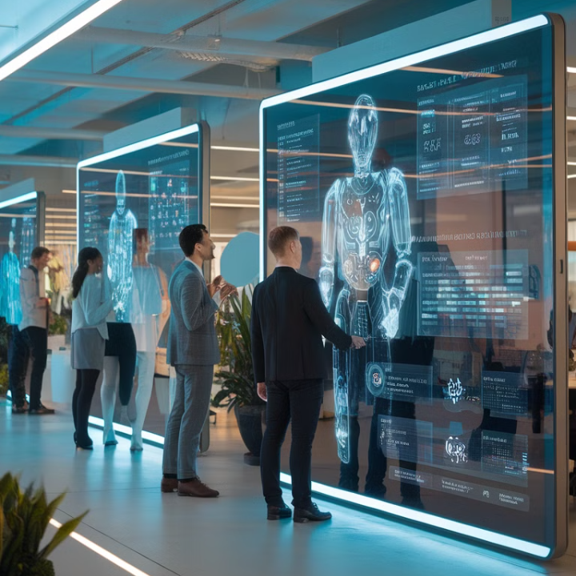
ProcurityIQ
Human-in-the-Loop:
Enhancing AI-Driven RFP Evaluations
Revolutionizing procurement with the perfect blend of artificial intelligence and human expertise.

The Power of Human-AI Collaboration
The human-in-the-loop system for AI-driven RFP evaluations combines the efficiency and analytical power of artificial intelligence with the nuanced understanding and decision-making capabilities of human experts. This hybrid approach ensures that evaluations are not only rapid and data-driven but also contextually appropriate and aligned with organizational goals.
By integrating human oversight, the system can handle complex scenarios, adapt to unique requirements, and continuously improve its performance based on expert feedback. This collaborative model leverages the strengths of both AI and human intelligence, resulting in more accurate, reliable, and transparent evaluation processes.
Initial AI Evaluation
The process begins with the AI system performing an initial evaluation of the RFP responses. This stage leverages advanced natural language processing and machine learning algorithms to analyze and score proposals based on predefined criteria. The AI examines technical specifications, financial details, compliance factors, and past performance data.
During this phase, the system can process large volumes of information quickly, identifying key points, potential risks, and areas of strength or weakness in each proposal. This initial AI evaluation provides a comprehensive baseline assessment, highlighting areas that may require further human scrutiny.
Document Ingestion
AI system ingests and processes RFP documents and vendor proposals
Criteria Matching
Proposals are analyzed and scored against predefined evaluation criteria
Initial Report Generation
AI generates a preliminary evaluation report highlighting key findings

Human Expert Review
Following the initial AI evaluation, human experts step in to review the AI-generated reports. These experts bring their domain knowledge, experience, and contextual understanding to the process. They examine the AI's findings, focusing on areas that require nuanced interpretation or where the AI has flagged potential issues or inconsistencies.
The human review phase is crucial for validating the AI's conclusions, identifying any overlooked factors, and ensuring that the evaluation aligns with the organization's strategic goals and procurement policies. Experts can also assess intangible aspects of proposals that may not be easily quantifiable by AI algorithms.
- Key Aspects of Human Expert Review
- Expert Qualifications
- Review Process Steps
Feedback Loop and AI Learning
Feedback Loop
- Enables continuous improvement of AI evaluation process.
Human Experts
- Review and refine AI-generated reports.
Training Data
- AI learns from human expertise to improve evaluations.
The system employs machine learning algorithms to analyze patterns in human expert feedback, adjusting its evaluation criteria, weighting factors, and decision-making processes accordingly. Over time, this iterative learning process enhances the AI's ability to produce more accurate and nuanced evaluations, reducing the need for extensive human intervention in routine cases.
Collaborative Decision-Making
The human-in-the-loop system facilitates collaborative decision-making between AI and human experts. After the initial AI evaluation and human expert review, the system enters a phase where final decisions are made through a collaborative process. This approach combines the data-driven insights of AI with the strategic thinking and contextual understanding of human experts.
In this stage, human experts can engage in discussions, compare different proposals, and consider factors that may not be fully captured by the AI system. The AI assists by providing real-time data analysis, answering queries, and generating visualizations to support the decision-making process. This collaboration ensures that final vendor selections and contract awards are based on a comprehensive evaluation that leverages both artificial and human intelligence.
AI Analysis
Provides data-driven insights and recommendations
Human Expertise
Contributes strategic thinking and contextual understanding
Collaborative Decisions
Final choices made through AI-human partnership
Outcome Optimization
Improved decision quality and procurement results
Customization and Flexibility
The human-in-the-loop system offers a high degree of customization and flexibility to adapt to various procurement scenarios and organizational requirements. This adaptability is crucial in handling diverse RFP evaluations across different industries, government agencies, or specialized sectors. The system allows for the configuration of evaluation criteria, weighting factors, and decision thresholds to align with specific procurement policies and objectives.
Human experts play a key role in this customization process, defining parameters and rules that guide the AI's evaluation approach. As new requirements or regulatory changes emerge, the system can be quickly adjusted to incorporate these updates, ensuring that evaluations remain compliant and relevant. This flexibility also extends to the level of human involvement, which can be scaled up or down depending on the complexity and criticality of each procurement process.
Configurable Criteria
Tailor evaluation parameters to specific procurement needs and industry standards
Adaptive Workflows
Adjust the level of human involvement based on procurement complexity
Regulatory Compliance
Quickly update system rules to align with changing regulations and policies
Scalable Solutions
Adapt the system to handle various procurement scales and complexities
Transparency and Explainability
A crucial aspect of the human-in-the-loop system is its emphasis on transparency and explainability in the AI-driven evaluation process. This feature addresses concerns about the "black box" nature of AI decision-making, particularly in sensitive procurement processes where accountability is paramount. The system is designed to provide clear explanations for its evaluations and recommendations, allowing human experts to understand and validate the AI's reasoning.
Through interactive dashboards and detailed reports, the system offers insights into the factors influencing each evaluation score. It can highlight specific sections of proposals that significantly impacted the assessment, provide comparisons between different vendors, and explain how various criteria were weighted. This transparency not only aids in decision-making but also supports audit trails and helps in addressing any challenges or inquiries about the procurement process.
| Feature | Benefit | Implementation |
|---|---|---|
| Explainable AI Algorithms | Clear reasoning behind evaluations | Use of interpretable ML models |
| Interactive Dashboards | Easy exploration of evaluation details | Visual analytics and drill-down capabilities |
| Audit Trails | Accountability and process validation | Comprehensive logging of AI and human actions |
| Comparative Analysis | Informed decision-making | Side-by-side vendor comparisons with explanations |
Bias Mitigation and Fairness
The human-in-the-loop system incorporates robust mechanisms for bias mitigation and ensuring fairness in the RFP evaluation process. AI systems can inadvertently perpetuate or amplify biases present in historical data or introduce new biases through algorithmic decisions. To counter this, the system employs a combination of AI fairness techniques and human oversight to identify and mitigate potential biases.
Human experts play a crucial role in reviewing AI evaluations for signs of bias, such as consistent favoritism towards certain types of vendors or unfair penalization of others. The system also incorporates fairness metrics and bias detection algorithms that flag potential issues for human review. Regular audits and diversity in the human expert team further contribute to maintaining a fair and equitable evaluation process.
Security and Confidentiality
Maintaining the security and confidentiality of sensitive procurement data is paramount in the human-in-the-loop system. The system incorporates multiple layers of security measures to protect against unauthorized access, data breaches, and potential cyber threats. These measures cover both the AI components and the interfaces used by human experts.
Advanced encryption protocols are employed for data at rest and in transit. Access controls and authentication mechanisms ensure that only authorized personnel can view and interact with sensitive information. The system also implements audit logging to track all user activities and AI operations, providing a comprehensive trail for security monitoring and compliance purposes. Regular security assessments and penetration testing help identify and address potential vulnerabilities.
Continuous Monitoring
Real-time threat detection and response capabilities safeguard against potential security breaches.
Scalability and Performance
The human-in-the-loop system is designed for scalability and high performance to handle varying volumes of RFP evaluations efficiently. Leveraging cloud-based infrastructure, the system can dynamically allocate resources to manage peak loads during busy procurement periods. This elasticity ensures that the AI components can process large numbers of proposals quickly without compromising on accuracy or response times.
For human experts, the system provides optimized interfaces and workflows that enhance productivity and reduce bottlenecks. Load balancing algorithms distribute work evenly among available experts, while intelligent queuing systems prioritize tasks based on urgency and complexity. Performance metrics are continuously monitored, allowing for real-time adjustments and long-term optimizations to maintain efficient operations at any scale.
Cloud Infrastructure
Elastic cloud resources automatically scale to meet demand
Load Balancing
Intelligent distribution of tasks among AI and human resources
Performance Monitoring
Real-time tracking of system metrics for optimization
Continuous Improvement
Ongoing refinement of algorithms and processes for enhanced efficiency
Integration with Existing Systems
The human-in-the-loop system is designed to seamlessly integrate with existing procurement and enterprise resource planning (ERP) systems. This integration capability ensures that the AI-driven evaluation process can leverage historical data, vendor information, and organizational policies while enhancing existing workflows with advanced AI capabilities and human expert oversight.
Data Import Architecture
Seamless ingestion of data from existing procurement and ERP systems through flexible API-based connections and data connectors
AI Processing Engine
Enhanced evaluation using AI algorithms combined with human expert input, leveraging historical data and organizational policies
Training and Adoption
Successful implementation of the human-in-the-loop system requires comprehensive training and support to ensure smooth adoption by procurement teams and stakeholders. The training program is designed to familiarize users with the AI-driven evaluation process, the role of human experts, and the collaborative decision-making approach. It covers both the technical aspects of using the system and the strategic considerations in leveraging AI insights for procurement decisions.
The adoption strategy includes phased rollouts, pilot programs, and ongoing support to help organizations transition to the new system effectively. Change management techniques are employed to address potential resistance and highlight the benefits of the AI-human collaboration. Regular feedback sessions and user surveys help identify areas for improvement and guide the continuous refinement of the system and training materials.
Comprehensive Training
In-depth courses on system usage and AI-human collaboration
User Support
Ongoing assistance and resources for system users
Phased Rollout
Gradual implementation to ensure smooth adoption
Feedback Loop
Continuous improvement based on user experiences
Future Developments and Roadmap
The human-in-the-loop system for AI-driven RFP evaluations is continuously evolving to incorporate emerging technologies and address changing procurement needs. The development roadmap focuses on enhancing AI capabilities, improving human-AI collaboration, and expanding the system's applicability across diverse procurement scenarios. Future developments aim to leverage advancements in natural language processing, predictive analytics, and cognitive computing to further streamline the evaluation process.
Planned enhancements include more sophisticated bias detection algorithms, improved explainable AI features, and integration with emerging blockchain technologies for enhanced transparency and security. The roadmap also includes the development of industry-specific AI models to provide more tailored evaluations for different sectors. Ongoing research collaborations with academic institutions and industry partners will drive innovation and ensure that the system remains at the forefront of procurement technology.

CONTACT
108 West Iowa Drive
Harker Heights, TX 76548
737-899-1501
MAIN LINKS
NEWSLETTER
Thank you for joining out email list. Keep an eye open for Procurity.ai news landing in your inbox soon!
Oops, there was an error sending your message. Please try again later.
Copyright Procurity Ai. All rights reserved.
Veteran Owned Company



























